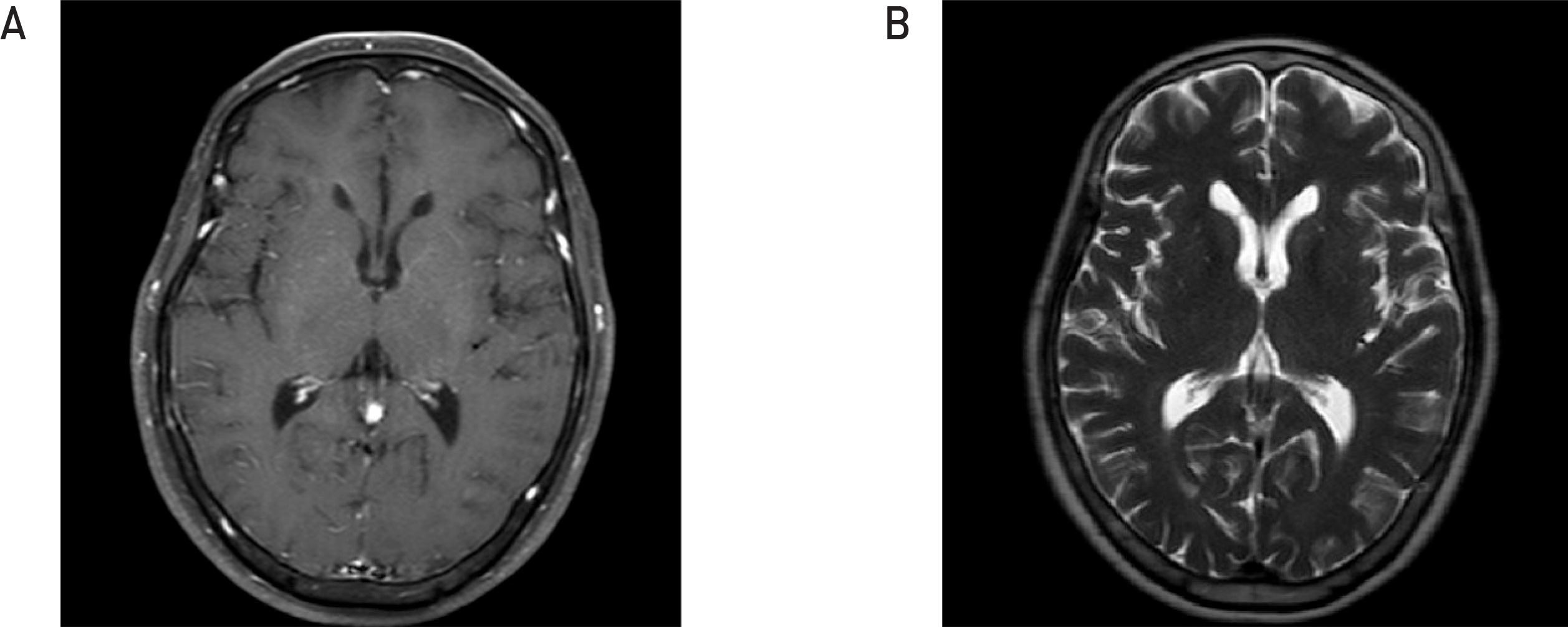Abstract
Monoballismus-monochorea is abnormal neurologic sign characterized by continuous, involuntary and irregular movement involving one extremity. Hyperglycemic ballism-chorea is predominantly observed in older type 2 diabetic patients and non-ketotic hyperglycemia, and is associated with contralateral striatal hyperintensities (i.e., putamen and caudate) on both brain CT and MRI. Movement disorders as the initial symptoms of diabetes mellitus are rare, especially in ketotic hyperglycemia. Here, we report one of these rare manifestations of transient monoballismus with during an episode of ketotic hyperglycemia without contralateral striatal abnormal findings on brain MRI in newly diagnosed diabetes mellitus.
Go to : 
References
1. Martin JP. Hemichorea (hemiballismus) without lesions in the corpus Luysii. Brain. 1957; 80:1–10.

2. Yetimalar Y, Seçkin M, Seçil Y, Başoğlu M. Lamotrigine-induced bilateral ballism. Mov Disord. 2007; 22:1832–3.

3. Ifergane G, Masalha R, Herishanu YO. Transient hemichorea/hemiballismus associated with new onset hyperglycemia. Can J Neurol Sci. 2001; 28:365–8.

4. Chang CV, Felicio AC, Godeiro Cde O Jr, Matsubara LS, Duarte DR, Ferraz HB, Okoshi MP. Chorea-ballism as a manifestation of decompensated type 2 diabetes mellitus. Am J Med Sci. 2007; 333:175–7.

5. Lai PH, Tien RD, Chang MH, Teng MM, Yang CF, Pan HB, Chen C, Lirng JF, Kong KW. Chorea-ballismus with nonketotic hyperglycemia in primary diabetes mellitus. AJNR Am J Neuroradiol. 1996; 17:1057–64.
6. Lin JJ, Chang MK. Hemiballism-hemichorea and non-ketotic hyperglycaemia. J Neurol Neurosurg Psychiatry. 1994; 57:748–50.

7. Awasthi D, Tiwari AK, Upadhyaya A, Singh B, Tomar GS. Ketotic hyperglycemia with movement disorder. J Emerg Trauma Shock. 2012; 5:90–1.

8. Dewey RB Jr, Jankovic J. Hemiballism-hemichorea. Clinical and pharmacologic findings in 21 patients. Arch Neurol. 1989; 46:862–7.
9. Oh SH, Lee KY, Im JH, Lee MS. Chorea associated with non-ketotic hyperglycemia and hyperintensity basal ganglia lesion on T1-weighted brain MRI study: a metaanalysis of 53 cases including four present cases. J Neurol Sci. 2002; 200:57–62.
10. Fujioka M, Okuchi K, Hiramatsu KI, Sakaki T, Sakaguchi S, Ishii Y. Specific changes in human brain after hypoglycemic injury. Stroke. 1997; 28:584–7.

11. Krieger D, Krieger S, Jansen O, Gass P, Theilmann L, Lichtnecker H. Manganese and chronic hepatic encephalopathy. Lancet. 1995; 346:270–4.

12. Fujioka M, Okuchi K, Sakaki T, Hiramatsu K, Miyamoto S, Iwasaki S. Specific changes in human brain following reperfusion after cardiac arrest. Stroke. 1994; 25:2091–5.

13. Lee BC, Hwang SH, Chang GY. Hemiballismus-hemichorea in older diabetic women: a clinical syndrome with MRI correlation. Neurology. 1999; 52:646–8.

14. Park CH, Lee DH, Yun M, Park S, Lee JD, Choi IS. Imaging evidence of basal ganglia pathology in hemi choreoballistic movement of the patient with nonketotic hyperglycemia: case report with serial follow up of neuroimages. J Korean Neurol Assoc. 2005; 23:117–20.
15. Kim HJ, Moon WJ, Oh J, Lee IK, Kim HY, Han SH. Subthalamic lesion on MR imaging in a patient with nonketotic hyperglycemia-induced hemiballism. AJNR Am J Neuroradiol. 2008; 29:526–7.
16. Shin HR, Kim JH, Park MY. Generalized choreaballismus associated with nonketotic hyperglycemia in diabetes mellitus: a case report. Yeungnam Univ J Med. 2002; 19:136–43.

17. Soysal DE, Gelen B, Hızar S, Pekdiker M, Tekesin E. Beckmann Y, Karakus V. Monoballism associated with newly onset ketotic hyperglycemia. Case Rep Endocrinol. 2012; 2012:202708.
Go to : 




 PDF
PDF ePub
ePub Citation
Citation Print
Print



 XML Download
XML Download